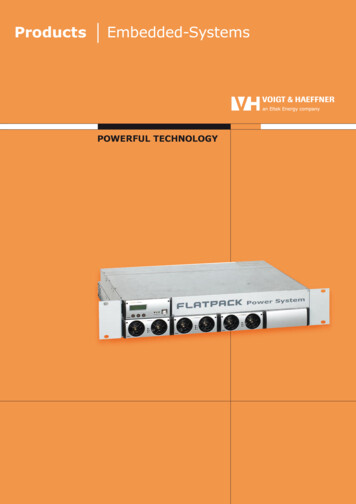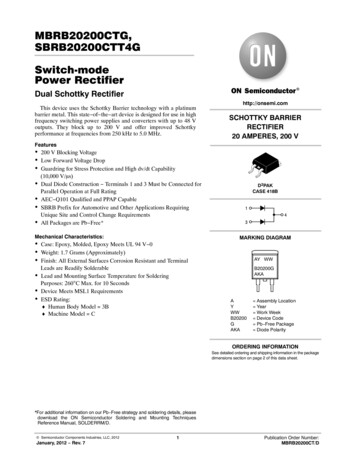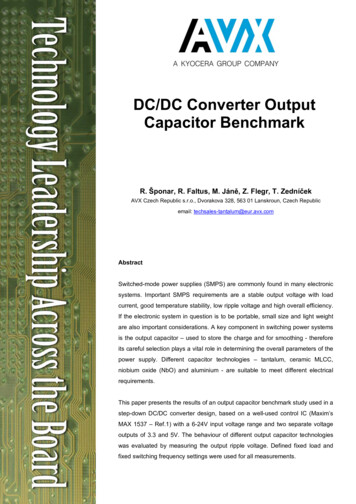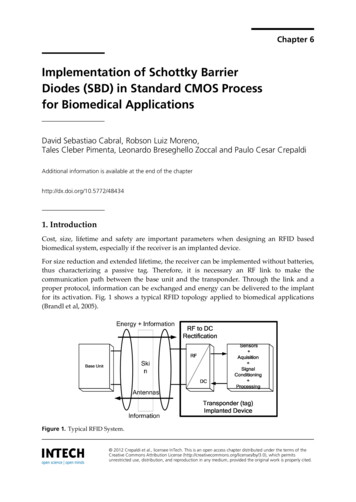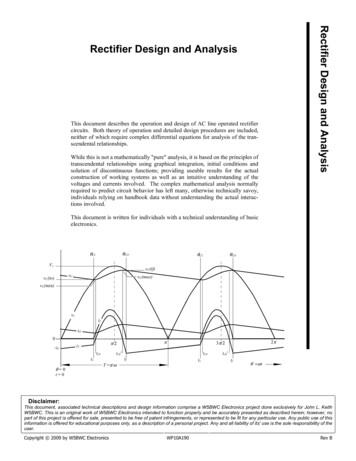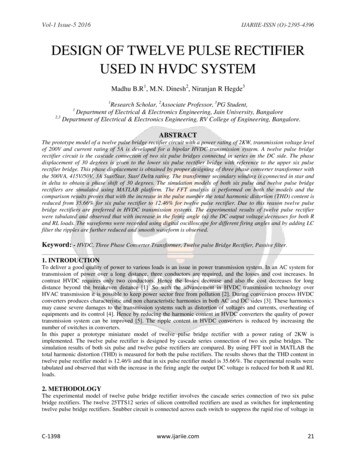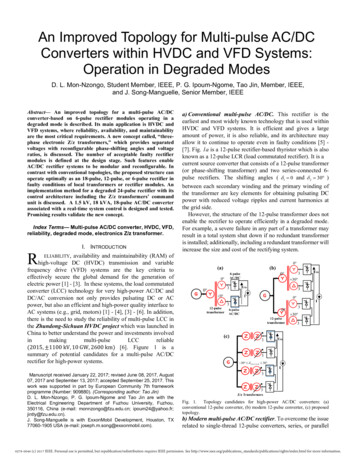
Transcription
Application NoteSLUA323 September 2004Current Doubler Rectifier Offers Ripple CurrentCancellationSteve MappusSystem PowerABSTRACTThe current doubler rectifier is a popular alternate choice for the output stage of a buckderived power converter, which would otherwise use a conventional center-tappedtransformer with secondary-side, full-wave rectification. Power topologies within this classwould include the push pull, half bridge and full bridge. There are many advantages that canbe gained by using a current doubler rectifier but by far the least mentioned is the ability tocancel ripple current seen at the output capacitor. Output ripple current cancellation reducesthe required output capacitance producing less noise at the power supply output. The degreeof ripple current cancellation is duty cycle dependent, so design specifications such as inputvoltage and transformer turns ratio need careful attention.1IntroductionAs illustrated in Figure 1, the current doubler uses two output inductors, each carrying half thetotal load current and operating at half the switching frequency. Initially, this may not seem likean advantage, especially considering that the full-wave approach uses only one output inductor.However, from an energy storage point of view, the total area product required for each case isthe same, so the total magnetic core volume is the same. Using two inductors in the outputstage additionally provides the ability to better distribute heat dissipation, which is especially aproblem with high current output designs. It is also critical that the currents in each outputinductor remain equal under all operating conditions. For this reason, current mode control is arequirement with the current doubler rectifier. To the designer, this should not be a problem,especially with the availability of advanced current mode PWM controllers such as the UCC3895Phase Shift PWM Controller or the UCC3808 Push Pull PWM Controller shown in Figure 1.Another benefit of the current doubler is the simplification of the transformer design. Without thecenter-tapped secondary, characteristic of all full-wave rectifiers, the transformer output is moreeasily terminated to the rest of the power stage. Also, a finer resolution in the transformer turnsratio is possible since the two secondaries of the full-wave rectifier are now replaced with asingle secondary winding in a current doubler application.For higher current, low voltage applications, the current doubler also makes control drivensynchronous rectification much simpler because each output rectifier is referenced directly tosecondary ground. Having the output rectifiers both referenced to ground eliminates the need todevelop a high-side gate drive, allowing the use of a low-side MOSFET gate driver such as theUCC37324 shown in Figure 1. This results in less circuitry, saving precious board space, and agreater selection of low-side gate driver devices to choose from.1
2Current Doubler Rectifier Offers Ripple Current Cancellation4 RC3 CS2 FBGND 5OUTB 6OUTA 71 COMP VDD 8UCC3808xQBT2QAVIN 48 V(36 V VIN 72 V)1T1Q SR2Q SR1UCC37324VDD 61 N/CN/C82 INA OUTA 73 GND4 INB OUTB 5L22.5 µHL12.5 µHCOUT1 VOUTVOUT 3.3 V VOUTSLUA323 September 2004Figure 1. Push-Pull Converter With Synchronous Current Doubler RectifierUDG 04121
SLUA323 September 2004Ripple Current CancellationWhile all of these benefits are noteworthy, perhaps the greatest motivation for using the currentdoubler rectifier is the reduced ripple current seen by the output capacitors. In some sense, thecurrent doubler rectifier can be thought of as a two-phase, interleaved synchronous buck. Asshown in Figure 2, maximum ripple current cancellation for a two-phase synchronous buckoccurs when each phase is operating at 50 percent duty cycle. However, because thevolt-seconds applied to the transformer primary must be equal for each half of the powertransfer cycle, the current doubler is limited to a maximum duty cycle of 50 percent per phase,whereas the two-phase synchronous buck can operate at greater than 50 percent duty cycle perphase.RIPPLE CURRENTvsDUTY CYCLE1.00.90.8K Ripple Cancellation Ration20.70.60.50.40.30.20.10.00.00.10.20.30.4 0.50.60.70.80.91.0D Per Phase Duty CycleFigure 2.In terms of ripple current cancellation, one of the biggest differences between the two-phasebuck and the current doubler is the way that the duty cycle is defined by the power transferfunction. For the buck regulator, the transfer function is simply the ratio of VOUT to VIN. Thecurrent doubler rectifier transfer function is given in equation (1).V OUT D2 NV IN(1)Here, D is the duty cycle defined as the total positive and negative power transfer duty cycle,and N is the primary to secondary transformer turns ratio. From Figure 1, QA and QB are eachlimited to 50 percent duty cycle each, however the total power transfer duty cycle seen at thecurrent doubler can approach 100 percent.Current Doubler Rectifier Offers Ripple Current Cancellation3
SLUA323 September 2004Using the waveforms of Figures 3 and 4, taken from the current doubler rectifier of Figure 1, anexpression for ripple current cancellation can be derived for the current doubler rectifier.L1 AND L2 RIPPLE CURRENT190 kHzIL12 A/div.IL22 A/div.t Time 1 µs/div.Figure 3.L1 AND L2 OUTPUT RIPPLE CURRENTIL12 A/div.IL22 A/div.IOUT5 A/div.6.3 APP380 kHz4.5 APPt Time 1 µs/div.Figure 4.4Current Doubler Rectifier Offers Ripple Current Cancellation
SLUA323 September 2004The peak current for each individual inductor can be defined as:ȡVNIN * VOUTȣDI L ȧȧLȢȤDF(2)Which simplifies to:DI L V IND * ǒDFV OUTǓNN(3)LThe output peak ripple current, which is really the sum of the two inductor currents, IL1 and IL2can be defined as:ȡVNIN * VOUTȣDI OUT ȧȧLȢȤD * V OUTLFDF(4)Which simplifies to:DI OUT D * ǒ2V INFDNV OUTǓN(5)LKnowing the peak values for the individual inductor current and the out ripple current, the ripplecancellation factor, K, is now defined and simplified to give:K V INDI OUT DI LVD * ǒ2IND * ǒDDNNV OUTǓV OUTǓ(6)And from the current doubler power transfer function defined by Equation (1), the duty cycle isgiven as:D V OUTV IN2N(7)Current Doubler Rectifier Offers Ripple Current Cancellation5
SLUA323 September 2004Substituting the value of D from (7) into the expression for K from (6) and simplifying gives:K 1*D1*D(8)2Equation (8) can now be plotted against D for 0 D 1 to graphically show the ripple currentcancellation effect for the current doubler rectifier.RIPPLE CURRENT CANCELLATIONvsDUTY CYCLE ( VOUT 3.3 V, 36 V VIN 72 V)1.0N 3K Ripple Cancellation Ratio0.90.8N 40.70.60.50.40.30.20.10.00.00.10.20.33 0.440.3 0.4 0.50.660.880.6 0.7 0.8 0.91.0D Power Transfer Duty CycleFigure 5.Figure 5 shows a graphical representation of the ripple current cancellation effect that would beexpected for a current doubler rectifier. The defined areas for N 4 and N 5 show the effectthat transformer turns ratio has on ripple cancellation for a 3.3-V (plus 0.7-V drop) typicaltelecom converter operating from an input voltage range of 36 V VIN 72 V. Notice that forlarger values of N, the ripple cancellation ratio moves closer to zero. For example, when N isequal to four, the duty cycle varies between 0.44 for VIN 72 V and 0.88 for VIN 36 V,corresponding to a minimum cancellation ration of 0.7 where the ripple current is reduced by 30percent, to a maximum cancellation ratio of 0.25 equaling a reduction of 75 percent. Clearly thetransformer turns ratio deserves careful consideration as it has a direct effect upon the amountof output ripple current cancellation that can be achieved.6Current Doubler Rectifier Offers Ripple Current Cancellation
SLUA323 September 20043Benefits of Reducing Output Ripple CurrentAs can be seen by comparing the waveforms of Figure 4 to Figure 3, the frequency of the outputripple current is twice the frequency of each individual inductor ripple current. This higherfrequency ac ripple current results in lower output capacitance, or lower inductor value for thesame output ripple current obtained using a full-wave rectifier. Having already calculated theoutput ripple current in (5), we can derive an expression for the required output capacitance.DI OUT C dv CdtdvFD(9)Equating (9) to (5) gives:CdvD * ǒ2F V INDFDNNV OUTǓ(10)LAnd solving for C gives:C DƪVIN * ǒ2F2NDLNV OUTǓƫdv(11)Many factors, such as transient response and ESR, come into play when determining theminimum required output capacitance. However, from (11) it should be noted that when thefrequency is doubled the required capacitance is reduced by a factor of four. Also from (9) it canbe shown that capacitance is directly proportional to ripple current.Using a current doubler rectifier helps minimize the required output capacitance by reducing theamount of output ripple current seen by the output capacitor. The degree to which this isachievable increases with duty cycle. While there are many factors to consider when designingthe power transformer, a higher turns ratio will produce a greater degree of ripple cancellation.Reduced ripple current also results in lower noise levels at the power supply output, translatingto lower radiated emissions. When considering a push pull or bridge topology for mid tohigh-power, high-current power supply applications, the current doubler rectifier offers manybenefits worthy of careful consideration.4References1. The Current Doubler Rectifier: An Alternative Rectification Technique For Push-Pull andBridge Converters, by Laszlo Balogh, Texas Instruments Application Note, Literature No.SLUA1212. Design Review: 100W, 400KHz, DC/DC Converter With Current Doubler SynchronousRectification Achieves 92% Efficiency, by Laszlo Balogh, Texas Instruments Literature No.SLUP1113. Configuring the UCC3895 for Direct Control Driven Synchronous Rectifier Applications, bySteve Mappus, Texas Instruments User’s Guide, Literature No. SLUU109A4. UCCx8083/4/5/6, 8-Pin Current Mode Push-Pull Controllers With Programmable SlopeCompensation, Texas Instruments Datasheet, Literature No. SLUS488B5. UCCx7323/4/5, Dual 4-A Peak High Speed Low-Side Power MOSFET Drivers, TexasInstruments Datasheet, Literature No. SLUS492BCurrent Doubler Rectifier Offers Ripple Current Cancellation7
IMPORTANT NOTICETexas Instruments Incorporated and its subsidiaries (TI) reserve the right to make corrections, modifications,enhancements, improvements, and other changes to its products and services at any time and to discontinueany product or service without notice. Customers should obtain the latest relevant information before placingorders and should verify that such information is current and complete. All products are sold subject to TI’s termsand conditions of sale supplied at the time of order acknowledgment.TI warrants performance of its hardware products to the specifications applicable at the time of sale inaccordance with TI’s standard warranty. Testing and other quality control techniques are used to the extent TIdeems necessary to support this warranty. Except where mandated by government requirements, testing of allparameters of each product is not necessarily performed.TI assumes no liability for applications assistance or customer product design. Customers are responsible fortheir products and applications using TI components. To minimize the risks associated with customer productsand applications, customers should provide adequate design and operating safeguards.TI does not warrant or represent that any license, either express or implied, is granted under any TI patent right,copyright, mask work right, or other TI intellectual property right relating to any combination, machine, or processin which TI products or services are used. Information published by TI regarding third-party products or servicesdoes not constitute a license from TI to use such products or services or a warranty or endorsement thereof.Use of such information may require a license from a third party under the patents or other intellectual propertyof the third party, or a license from TI under the patents or other intellectual property of TI.Reproduction of information in TI data books or data sheets is permissible only if reproduction is withoutalteration and is accompanied by all associated warranties, conditions, limitations, and notices. Reproductionof this information with alteration is an unfair and deceptive business practice. TI is not responsible or liable forsuch altered documentation.Resale of TI products or services with statements different from or beyond the parameters stated by TI for thatproduct or service voids all express and any implied warranties for the associated TI product or service andis an unfair and deceptive business practice. TI is not responsible or liable for any such statements.Following are URLs where you can obtain information on other Texas Instruments products and samplifier.ti.comAudiowww.ti.com/audioData andInterfaceinterface.ti.comDigital ilitarywww.ti.com/militaryPower Mgmtpower.ti.comOptical Telephonywww.ti.com/telephonyVideo & Mailing Address:Texas InstrumentsPost Office Box 655303 Dallas, Texas 75265Copyright 2004, Texas Instruments Incorporated
corresponding to a minimum cancellation ration of 0.7 where the ripple current is reduced by 30 percent, to a maximum cancellation ratio of 0.25 equaling a reduction of 75 percent. Clearly the transformer turns ratio deserves careful consideration as it has a direct effect upon the amount of output ripple current cancellation that can be .

